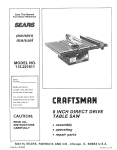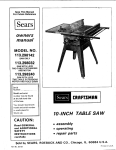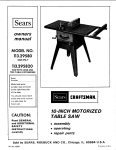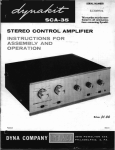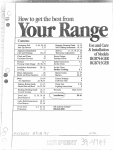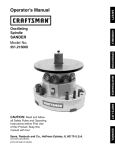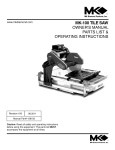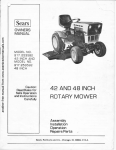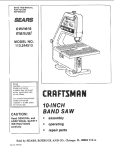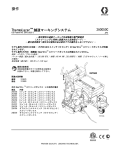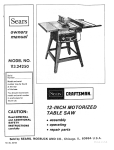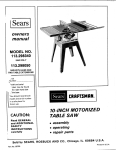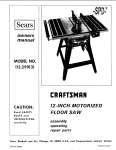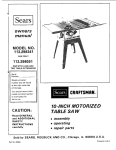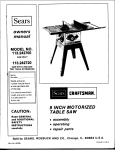Download Craftsman 113.295750 Owner`s manual
Transcript
ISears]
owners
manual
MODEL NO.
113.29570
SAW ONLY
113.295750
SAW WITH LEGS AND
TWO TABLE EXTENSIONS
Serial
Number
.......
Model and serial
number may be found
at the right-hand
of the base.
side
CRAFTSMAN°
You should record both
model and serial number
in a safe place for
future use,
IO-INCH MOTORIZED
TABLE SAW
CAUTION:
Read
GENERAL
and ADDITIONAL
SAF ETY
• assembly
INSTRUCTIONS
• operating
carefully
Sold by SEARS,
Part No. 62716
• repair
ROEBUCK
AND
parts
CO.,
Chicago,
IL
60684
U.S.A.
Printed in U_S.A.
FULL ONE YEAR WARRANTY
ON CRAFTSMAN
If within one year from the date of purchase, this Craftsman
workmanship,
Sears will repair it. free of charge.
WARRANTY
OR SERVICE
SERVICE
CENTER
IS AVAILABLE
THROUGHOUT
This warranty
state,
gives you specific
BY SIMPLY
THE UNITED
Table Saw fails due to a defect
CONTACTING
STATES,
legal rights, and you may
TABLE SAWS
THE
also have other
NEAREST
in material
SEARS
rights which
or
STORE
vary from
state to
SEARS. ROEBUCK AND CO.. Sears Tower. BSC 41-3. Chicago, ]L 60664
general
safety instructions
1. KNOW YOUR
Read
the
aoDlication
potenttal
hazards
peculiar
ALL
Th ; tool
to this
Learn
ts
the specific
with
an approved
3. KEEP GUARDS
and
n
4. REMOVE ADJUSTING
AND WRENCHES
Form
habit
wrenches
of checking
proper
areas
must not
6. AVOID
Don't
expose
Provide
7.
and
be slippery
from
tool
benches
before
turning
it on,
accidents.
- with
padlocks,
starter keys.
in damp
or wet
{ocations
or
switches,
f_om
Work
accessories.
hazards.
STARTING
OFF
poston
before
by
removing
....
use of
store
materials
it is necessary
plugging
11. WEAR PROPER APPAREL
Do not wear loose clothing,
gloves, neckties or jewelry
(rings, wrist
watches)
to get caught
in moving
parts.
Wear protective
Roll long sleeves
12. USE SAFETY
GOGGLES
(Head ProtectiOn)
Wear Safety goggles (must comply with ANSI Z87.1)
at all times. Everyday eyeglasses only have impact
resistant lenses, they are NOT safety glasses. Also, use
face or dust meal( if cutting operation is dusty; and ear
accessories
above or near the tool
Check
properly
for alignment
may
or if the
such that
to reach them.
PARTS
Before further
use of the tool,
is damaged should be carefully
witl operate
it was not
improper
to stand on the tool
20, CHECK DAMAGED
to do a job
is recommended.
contain
long hair.
The
NEVER
STAND
ON TOOL
_ ....
benous Injury eou d occur if the to01 is tipped
cutting tool is accidentally
contacted.
Do not
or
and safer at the rate for which
or attachment
the
Cause
TOOL
Nonslip
footwear
hair covering
to
above the elbow
is 'n
accessoHes such as
18. USE RECOMMENDED
ACCESSORIES
Consult
the owner's
manual for
recommended
accessories. Follow the instructions that accompany
lighted,
KID-PROOF
master
FORCE TOOL
Don't force tool
designed for.
ACCIDENTAL
Make sure switch
in.
i9
AWAY
be kept a safe distance
It will do the job better
it was designed.
10. USE RIGHT
17. AVOID
Floor
ENVIRONMENT
tools
8. MAKE WORKSHOP
9. DON'T
mvite
TOOLS
before serv=cmg; when changing
blades, bits. cutters etc
keys and adjusting
them to rain. Keep work area well
adequate surrounding
work space,
KEEP
CHILDREN
AII visitors
should
area.
MAINTAIN
TOOLS WITH CARE
Keen tools sharp and clean for oest and safest
performance. Follow instructions for lubricating and
changing accessories
clue to wax or sawdust.
DANGEROUS
use power
15.
16. DISCONNECT
5. KEEP WORK AREA CLEAN
Cluttered
OVERREACH
Keep proper footing and balance at all times.
and
KEYS
to see that
are removed
adjustment
during extended periods of
14. DON'T
IN PLACE
order,
(plugs or muffs]
WORK
Use clamos or a vise to hold work when practical, t's
safer than using your hand. frees both hands to operate
tool
3*conductor
coro and a 3*prong grounding
tvoe
plug Io fit the
Drouer grounamg [yDe receptacle.
The green conauctot
'n me cord _s the grounding
w_re. Never connect the
green wire to a live terminal
tools
13. SECURE
tool
TOOLS
s equipped
n
working
alignment.
protectors
operation.
POWER TOOL
owner's
manual
carefull,_.
and limitations
as well as
2. GROUND
for power
a guard or other part that
checked to ensure that it
and perform
of moving
its intended
parts,
binding
function.
of moving
parts,
breakage
conditions
that
of parts,
mounting,
and any other
may .affect its operation.
A guard or
other part that
or replaced.
is damaged
21. DIRECTION
Feed work
of rotation
should
OF FEED
be properly
.....
into a blade or cutter against
of the blade or cutter only.
22, NEVER LEAVE
UNATTENDED
Turn
power off.
complete
stop.
TOOL
Don't
repaired
the direction
RUNNING
leave tool
until
it comes
to a
ADDITIONAL
SAFETY INSTRUCTIONS
FOR TABLE SAWS
WARNING:
FOR YOUR OWN SAFETY,
DO NOT
OPERATE YOUR SAW UNTIL
IT IS COMPLETELY
ASSEMBLED AND INSTALLED
ACCORDING TO THE
INSTRUCTIONS
... AND UNTIL YOU HAVE READ
AND UNDERSTOOD THE FOLLOWING.
1
2.
3,
4,
5.
6.
contact
thrown
can usually
spreader
GENERAL SAFETY INSTRUCTIONS
FOR POWER
TOOLS...
SEE PAGE 2
GETTING TO KNOW YOUR SAW...
SEE PAGE 15
BASIC SAW OPERATION...
SEE PAG E 17
ADJUSTMENTS...
SEE PAGE 23
MAINTENANCE...
SEE PAGE 26
STABILITY OF SAW
If there _sany tendency for the saw to tio over or move
during certain cutting
operations
such as cutting
extremely large heavy panels or long heavy boards, the
saw should be bolted down.
If you attach any kind of table extensions over 24"
wide to either end of the saw, make sure you either
bolt the saw to the bench or floor as appropriate, or
support the outer end of the extension from the bench
or floor, as appropriate.
LOCATION
The saw should be aositioned
nor a casual observer is forced
D=
Use extra
caution
when the guard assembly is
removed
for
resawmg,
dadoing,
rabbeting,
or
molding
-- replace
the guard
as soon as that
operation
is completed,
E.
NEVER
turn the saw "ON"
before clearing
the
table
of all tools, wooa
scraos, etc,, except
the
workpiece
and related feed or support
devices _for
the operation
planned.
NEVER
place your face or body in line with
the
cutting tool.
NEVER
place vour fingers or hands in the path of
the sawblade or other cutting
tool.
NEVER
reach in back of the cutting
tool with
either hand to hold down or support the workplace,
remove wood scraos, or for any other reason. Avoid
awkward
operations
and hand positions
where a
sudden
slip could
cause fingers
or hand to move
into a sawolade or other cutting tool.
F.
G.
H.
so neither
the ooerator
to stand in hne with the
KICKBACKS
Kickbacks
can cause serious injury:
occurs when a part of the workplece
sawblade and the rip fence or other
from the table, and is thrown
toward
I.
A "KICKBACK'"
binds between the
fixed object, rises
the operator,
J,
<eeD your face and body to one side of the sawblade,
out of line with a possible "Kickback.'"
Kickbacks
and possible injury
from
them
can
usually be avoided by:
A, Maintaining
the rip fence paragel to the sawblade.
B. Keeping the sawblade sharp. Replacing
antikickback
C.
D.
E.
F.
K.
pawls when points become dull.
Keeping sawblade guard, spreader, and antikickback
pawls in place and operating
properly.
The spreader
must be in alignment
with
the sawblade and the
pawls must stop a kickback
once it has started.
Check their action before ripping.
NOT ripping work that is twisted or warped or does
not have a straight edge to guide along the rip fence,
NOT releasing work untiI you have pushed it all the
H.
9.
When ripping
the workpiece
fence.
apply the feed force to the section of
between
the saw blade and the rip
PROTECTION:
EYES, HANDS,
FACE, EARS, BODY
A. If any part of your saw is malfunctioning,
has been
damaged or broken..,
such as the motor switch, or
orher
operating
contlol,
a safety d_vice
or the
power
cord ,., cease operating
immediately
until
the particular
part is properly
repaired or replaced.
B.
C.
Wear safety
and a face
goggles that comply
shield
if operation
plugs
or
operation.
muffs
Small
pieces
loose
with ANSI Z87.1,
is dusty. Wear ear
during
extended
of wood
or other
periods
objects
of
that
DO NOT perform
alwa_,,s use either
any operation
"FREEHAND'"
the np fence or the miter gauge to
oosition
and guide the work.
NEVER
use the rip fence when crosscutting
or the
miter
gauge when ripping.
DO NOT
Jse the rip
fence as a length stop.
Never hold onto or touch
the "free end" of the
workpiece
or a "'free piece*' that is cut off, while
power is "ON"
and/or the sawblade is rotating.
Shut "OFF"
the saw and disconnect
the power cord
when
removing
the
table
insert,
changing
the
cutting
tool, removing or replacing the blade guard,
or making adjustments.
L. Provide adequate
support
to the rear and sides of
the saw table for wider or long workpieces.
M. Plastic and composition
(like hardboard)
materials
may be cut on your saw. However, since these are
usually
quite
hard and slippery,
the antikickback
pawls may not stop a kickback.
Therefore,
be especially
attentive
to following
proper
set-up and cutting
procedures
for ripping.
Do not stand, or permit anyone else to stand, in line
with a potential
kickback.
way past the sawbiade.
Using a "PUSH
STtCK"
(See Page 16) for ripping
widths of 2 to B in., and an auxiliary
fence and push
block for ripping widths
narrower than 2 in. (See
"Basic Saw Operation
UsJngTbe Rip Fence" section.)
G. NOT confining
the cut-off
piece when ripping
or
crosscutting,
be avoided by keeping the guard and
n
glace
for all "THRU-SAWING"
operations (sawing entirely thru the work) AND by
remowng all loose pieces from the table with a long
stick of wood IMMEDIATELY
after they are cut
off.
saw blade.
8.
the rear of the revolving blade can be
back at the operator at excessive speed. This
N.
DO NOT perform
layout, assembly, or setup
on the table while the cutting tool is rotating.
work
O.
If you stall or jam the sawblade in the workpiece,
turn saw "OFF",
remove
the workpiece
from the
sawblade,
and check
to see if the sawblade is
parallel
to the miter
gauge grooves and if the
spreader is in proper alignment
with the sawblade.
If ripping at the time, check to see if the rip fence is
parallel with the sawblade. Readjust as indicated.
10. KNOW YOUR CUTTING
TOOLS
A Dul!, gummy, or improperly
sharpened or" set cutting
tOOIS can cause material to stick, jam, stall the saw,
or kickback
at the operator.
Minimize
potential
injury
by proper
cutting
tool
and machine maintenance.
NEVER
ATTEMPT
TO
FREE
A STALLED
SAWBLADE
WITHOUT
FIRST
TURNING
THE
SAW OFF.
B.
Never use grinding wheels, abrasive cut-off wheels,
friction wheels (metal slitting blades) wire wheels or
buffing wheels,
11. USE
ONLY
ACCESSORIES
DESIGNED
FOR
16. Never feed material into the cutting tool from the rear
of the saw. An accident and serious injury could result.
17. THINK SAFETY.
Safety is a combination of operator common senseand
alertness at all times when the saw is being used,
18. NOTE
AND FOLLOW SAFETY
INSTRUCTIONS
THAT APPEAR ON THE FRONT OF YOUR SAW,
THIS
SAW.
12, Crosscutting
operations
and with greater safety
are more conveniently
f an auxiliary
wood
worked
facing is
attached to the miter gauge using the holes provided.
However. the facing must not interfere with the proper
functioning
of the sawbtade guard.
13. Make sure the top of the arbor or cutting tool rotates
toward
you
when
standing
ir
normal
operating
aosition.
Also make sure the cutting tool, arbor collars
and arbor nut are installed properly.
Keep the cutting
tool
as Fow as possible
for
the
operation
being
performed.
Keep all guards in place whenever
possible.
14. Do not use any blade or other cutting tool marked for
an operating
speed less than 3450
RPM. Never use a
cutting tool
larger in diameter
than the diameter
for
which
the saw was designed.
For greatest safety and
efficiency
when ripping,
use the maximum
diameter
blade for which the saw is designed, since under these
conditions
the spreader is nearest the blade,
15. Adjust
table inserts flush with
the table top. NEVER
Operate the saw unless the _roper insert is installed.
WEAR
1.
2.
3.
4.
5.
6.
7.
DANGER
FOR YOUR OWN SAFETY
READ AND UNDERSTAND OWNER'S MANUAL
BEFORE OPERATING MACHINE:
WEAR SAFETY GOGGLES
USE SAW-BLADE GUARD FOR "THRU-SAWING"
KEEP HANDS OUT OF PATH OF SAWBLADE
USE A "PUSH-STICK" WHEN REQUIRED
KNOW HOW TO AVOID "'KICKBACKS'"
DO NOT PERFORM OPERATI ONS "FREEHAND"
NEVER REACH AROUND OR OVER SAW BLADE
19. WARNING:
DO NOT
ALLOW
FAMILIARITY
(GAINED FROM FREQUENT USE OF YOUR SAW)
TO
BECOME
COMMONPLACE.
- ALWAYS
REMEMBER THAT A CARELESS FRACTION OF A
SECOND IS SUFFICIENT
TO INFLICT
SEVERE
INJURY.
YOUR
The operation
of any power
tool can result in foreign
objects being, thrown
into the eyes, which can result m
severe eye damage. Always
wear safety goggles complying
with
ANSI Z87.1 (shown on Package) before commencing
power tool operation.
Safety Goggles are available at Sears
retail or catalog stores.
MOTOR SPECIFICATIONS
AND
ELECTRICAL
REQUIREMENTS
MOTOR SPECI FICATIONS
The AC motor used in this saw is a capacitor start,
non-reversible type, with the following specifications:
Voltage .................................
120
Amperes .................................
12
Hertz
..................................
60
Phase ...............................
Single
RPM
.................................
3450
Rotation (viewec[ from
Sawblade end)
..............
Counterclockwise
3.
4.
a fuse of greater capacity
company,
5
MOTOR
SAFETY
PROTECTION
The saw motor
is equipped
with a manual-reset
thermal
overload
protector,
designed to open the power line circuit
when the motor temperature
exCeeds a safe value.
NOTE:
The starting
TYPE. NEVER TURN
IS UPSIDE
DOWN
MOTOR
1,
2.
6.
relay
is a GRAVITY
SENSITIVE
THE POWER ON WHILE
THE SAW
AS THiS
WILL
DAMAGE
THE
consulting
the power
Although
the motor
is designed
for operation
on the
voltage and frequency
specified
on motor
nameplate,
normal
loads will
be handled
safely
on voltages not
more than 10% above or below the maneplate
voltage.
Heavy loads, however,
require
that voltage
at motor
terminals
by no_ less than the voltage
specified
oll
nameplate.
Most
motor
troubles
may
be tracec
to loose or
the supply
circuit}
or when
the supply circuit
is
extremely
long.
Always
check connection,
load and
supply
circuit
when
the
motor
fails
[o aertorrn
satisfactorily.
Check
end of this section.
After
cooling
to a safe operating
temperature,
the
overload protector
can be closed manually
by pushing
in the red RESET button on the front of the saw. If the
while
without
incorrect
connections,
overloading,
reduced
input
voltage (which
results when small size wires are used i=_
If the protector
opens the line and stops the saw motor,
move
the saw switch
lever to the "OFF"
position
immediately
and allow the motor to cool.
red I_utton
Will not snag into
motor is still too hot and must
As soon as the red button
wi
snap into
running
position,
the saw may be started and operated normally
by moving the saw switch lever to the "ON"
position.
Frertuent opening of fuses or circuit
breakers may result
if motor
is overloaded,
or if the motor circuit
is fused
with a fuse other than those recommended,
Do not use
wire sizes and lengths with
table at
CONNECTING
TO POWER SOURCE OUTLET
This saw must be grounded while in use to protect
operator from electrical
shock.
place immediately,
the
be allowed to coo! for a
If power cord is worn or cut,
have it replaced immediately.
longer.
4
or damaged
the
in anv way,
"If yoursawis
for use on lessthan 150 volts it has a plug
that looks like below.
3-PRONG
PLUG
\
An adapter as shown below is available for conne_ing plugs
to 2-prong receptacles, The green grounding lug extending
from the adapter must be connected to a permanent ground
such as to a properly grounded outlet box.
GROUNDING PRONG
PROPERLY
GROUNDED
3-PRONG
OUTLET
If the outlet you are planning to use for this saw is of the
two prong type DO NOT REMOVE OR ALTER THE
GROUNDING
PRONG IN ANY MANNER. Use an adapter
as shown and always connect the groundi.g lug to a known
ground.
It is recommended that you have a qualified electrician
replace the TWO prong outlet with a properly grounded
THREE 10rongoutlet.
Plug power cord into 110-120V properly grounded type
outlet protected by a 1S-amp. time delay or Circuit-Saver
fuse or circuit breaker.
IF YOU ARE NOT SURE THAT YOUR OUTLET IS
PROPERLY GROUNDED,
HAVE IT CHECKED BY A
QUALI FlED ELECTRICIAN.
WARNING:
DO NOT PERMIT FINGERS TO TOUCH
THE TERMINALS
OF PLUG WHEN INSTALLING
OR
REMOVING THE PLUG TO OR FROM THE OUTLET,
WARNING:
IF NOT PROPERLY
GROUNDED
THIS
POWER TOOL CAN INCUR THE POTENTIAL HAZARD
OF ELECTRICAL
SHOCK, PARTICULARLY
WHEN
USED IN DAMP LOCATIONS:
IN PROXIMITY
TO
PLUMBING, OR OUT OF DOORS. IF AN ELECTRICAL
SHOCK OCCURS THERE IS THE POTENTIAL
OF A
SECONDARY
HAZARD
SUCH AS YOUR HANDS
CONTACTING THE SAWBLADE.
This saw is equipped with a 3_conductor cord and
grounding type plug which has a grounding prong, approved
by Underwriters' Laboratories and the Canadian Standards
Association, The ground conductor has a green lug and is
attached to the toot housing at one end and to the ground
prong in the attachment plug at the other end.
This plug requires a mating 3-conductor grounded type
outlet as shown.
GROUNDING
LUG
ADAPTER
\
3-PRONG
PLUG
MAKE SURE THiS iS
CONNECTED
TO A
KNOWN
GROUND
2-PRONG
RECEPTACLE
NOTE: The adapter illustrated {sfor use only if you already
have a properly grounded 2-prong receptacle.
The use of any extension cord will cause some loss of
power. To keep this to a minimum
and to prevent
over-heating and motor burn-out, use the table below to
determine the minimum wire size (A.W.G.) extension cord.
Use only 3 wire extension cords which have 3 prong
grounding type plugs and 3-pole receptacles which w_ll
accept the plug on the saw.
Extension Cord Length
Upto 100 Ft ......................
100 - 200 Ft .......................
200 - 400 Ft .........................
Wire Size A,W.G.
12
10
8
CONTENTS
WARRANTY
.................................
GENERAL SAFETY INSTRUCTIONS
FOR POWER TOOLS
.................
ADDITIONAL
SAFETY INSTRUCTIONS
FOR TABLE SAWS ...........................
2
_.......
MOTOR SPECIFiCATiONS
AND ELECTRICAL
REQUIREMENTS
............................
UNPACKING AND CHECKING CONTENTS
........
Tools Needed ................................
List of Loose Parts ............................
ASSEMBLY
..................................
Installing Elevation and Tilt Handwheels ...........
Checking Table Insert .........................
Checking Blade Squareness to Table ..............
Checking Blade Elevation
......................
Attaching Table Extensions .....................
Installing Rip Fence Guide Bars ..................
Assembling Steel Legs ........................
Mounting Saw ..............................
Aligning Table Extensions .....................
Aligning Rip Fence ..........................
Installing Blade Guard ........................
GETTING TO KNOW YOUR SAW ...............
On-OffSwltah
..............................
Reset Button ...............................
Elevation Handwheel .........................
Tilt Handwheel .............................
Rip Fence .................................
Miter Gauge ................................
2
3
4
6
6
6
7
7
7
8
8
8
g
10
10
11
If
13
15
15
16
16
16
16
16
Blade Guard ................................
Table Insert ................................
Removingand InstallingSawblade ...............
BASIC SAW OPERATION USING THE MITER GAUGE
Work Helpers ...............................
Crosscutting ................................
Repetitive Cutting ...........................
Miter Cutting ...............................
Bevel Crosscutting
...........................
Compound Miter Cutting ......................
BASIC SAW OPERATION USING THE RIP FENCE ..
Ripping ...................................
Bevel Ripping
..............................
Rasaw_ng ..................................
Cutting Panels ..............................
Rabbeting
.................................
ADJUSTMENTS
..............................
Miter Gauge ................................
Heeling Adjustment or Parallelism of
Sawblade to Miter Gauge Groove ...............
Blade Tilt, or Squareness of
Blade to Table .............................
Blade Elevation .............................
Tilt and Elevation Mechanism ..................
MAINTENANCE
.............................
LUBRICATION
..............................
RECOMMENDED ACCESSORIES ................
TROUBLE SHOOTING
........................
REPAIR PARTS ..............................
16
16
17
17
17
18
lg
20
20
2(]
20
21
21
22
23
23
23
23
24
2,$
26
26
26
2'7
27
2,g
30
UNPACKING
z//_
AND CHECKING
WARNING:
FOR
YOUR
OWN SAFETY,
NEVER
CONNECT PLUG TO POWER SOURCE OUTLET UNTIL
ALL ASSEMBLY STEPS ARE COMPLETE, AND YOU
HAVE READ AND UNDERSTAND
THE SAFETY AND
OPERATIONAL
INSTRUCTIONS.
TOOLS NEEDED
Hammer
CONTENTS
Medium Screwdriver
Small Sorewdriver
LIST OF LOOSE PARTS
Key
No. PartName
Combination
112in. 9116in.
3/4 in.
Square
COMBINATION
SQUARE MUST BE TRUE.
S_AIGHT
3/4
DRAW LIGHT
ROARD
ALONG
LiNE
ON
I'HIS EDGE*
EDGE
THICK.
OF
_,)ARD
THIS EDG_ MUST
BE PERFECTLY STRAIGHT.
¢_\
\,
LJ
SHOULD BE NO
4ERE
WHEN
3AP OF
SQUARE
OVERLAp
{S FLII=PED
Qty,
A
B
C
D
Miter Gauge ..............................1
Rip Fence ...............................
1
BladeGuardand Spreader ...................
1
Handwheel...............................
2
E
F
G
H
J
K
Rip FenceGuideBar, Rear ..................
Rip FenceGuideBar Rod ...................
Rip FenceGuideBar with Rip Scale(Freut)
Arbor Wrench ............................
Arbor Nut Wrench .........................
OwnersMenuat ..........................
L
M
N
P
P
Pkg.of Miscellaneous
Small PartsNo. 627!7
Consistingof the Following:
SpreaderSupport ..........................
SpreaderClamp ...........................
SpreaderBracket .........................
SetscrewWrench,l/Sin .....................
SetscrewWrench,3/16 in....................
Q
R
S
Switch Key ..............................2
GuideBar Spacer ..........................
2
Soc, Hd. Set ScrewI/4-20 x 7/8 ..............
2
T
U
V
V
W
SquareNut, 1/4-20 ........................
SelfThreadingNut ........................
Flatwasher,(die,of hole 17/64 in.) ............
Flatwasher,(dia. of hole 21/64 in.) ............
Hex Nut, 1/4-20
{Approx.dia. of hole 1/4 in.) ...............
HexNut, 5/16-18
(approx.die. of hole5/16 in.) ...............
Lockwasher, 1/4 in. ExternalType
{approx.die, of hole1/4 in,] ...............
.....
1
1
1
1
1
1
1
1
1
1
1
OVER {N DOTTED POSITION.
Model t 13.29570 Motorized Table Sew is shipped complete
in one carton but DOES NOT INCLUDE Table Extensions
and Steel Legs.
Model
113.295750
Motorized Table Saw is shipped
complete in one carton but INCLUDES
TWO Table
Extensions and Steel Legs.
Separate all parts from packing materials and check each
one with the illustration and the list of Loose Parts to make
certain all items are accounted for, before discarding any
packing material,
If any parts are mtssing, do not attempt to assemble the
table saw, plug in the power cord or turn the switch on
until the missing parts are obtained and are installed
correctly.
A
B
W
X
°
j
H
G
6
2
2
4
4
2
4
4
X
Lockwasher,5/16 in. ExternalType
(approx.dia. of hole5/16 in.) ...............
4
X
Luckwashar-#10 ExternalType
(approx.die. of hole3/18 in.) ...............
WingScrew, 1/4-20 x 1/2 {n.long .............
Rex Hd. Screw, 5/16 - 18 x 1-1/2 im long .......
Hex Hd, Screw,5/16 - f8 x 1 in. tong ..........
Screw,Pro1Hd. 10-32 x 3/4 ..................
2
2
2
2
2
Y
Z
Z
AA
The following
E
F
F
G
G
G
D
parts are included with Model 113.295750
Key
No. Part Name
A
B
C
I1
B
Qty.
Leg . ....................................
Side Stiffener .............................
End Stiffener .............................
Table Extension ...........................
4
2
2
2
Pkg.of Misce!laneous
Small Parts,No. 62659
Consistingof the Following:
Hex HeadScrew5/16--18 x 1-1/4 in. long .....
Lockwashsr,1/4 in. ExternalType
(appmx. dia, of hole1/4 in.) ..............
6
24
Leckwasher, 5/16 in. ExternalType
(approx.dia. of hole 5/16 in.) .............
HexNut, 1/4-20
(approx.dia. of hole1/4 in.) ..............
HexNut, 5/16-]8
(approx.die. of hole5/16 in.) .............
Hex Nut, 1/2-13
(approx, die. af hole1/2 in.) ..............
6
24
H
FlatWasher(dia, of hole, 11/32 in.) ..........
S
J
8
K
TrussHeadScrew,1/4-20 x 5/8 in. long
(top of screwis rounded) .................
LevelingFoot ..... . .....................
6
24
4
III
ASSEMBLY
Before mounting the saw on legs, a stand or a bench, the
Table Insert and Blade Squareness and Blade Elevation
must be checked at this time,
LOCKWASHER
INSTALLING
1.
ELEVATION
AND
TILT
LOCKWASHER
HANDWHEELS
Line up FLAT SPOTS on shaft and handwheel, push
handwhee] onto shaft, Install screw and Iockwasber to
lock handwheel on shaft.
T
SCREW
SCREW
TILT HANDWHEEL
ELEVATION
HANDWHEEL
LEVELING
CHECKING
TABLEINSERT
I,
With the insert in place, and sawblade all the way down,
use a small scale or straight edge to check near each of
the eight leveling tab positions,
in order to determine
if
the insert is flush with saw table surface at all eight tab
locations.
2.
If the insert is above
must be adjusted.
A. Loosen Screw.
the table surface,
B.
Lift insert from
sew,
front
C.
Remove
the insert, place
workbench
end GENTLY
the leveling tabs
end, and pull toward
front
of
it upside down on your
TAP each of the tabs
downward only a slight amount.
Replace
check it and readjust tabs, if necessary.
insert...
7
TAB
3.
If the insert is BELOW the table surface, remove the
insert and bend the tabs (with pliers) enough to make
the insert ABOVE the table surface.
4.
To replace insert.
Place insert into insert opening in table and push
toward rear of saw to engage spring clip and until
keyslot in insert wi!l drop over screw. Tighten screw.
DO NOT TIGHTEN SCREW TO THE POINT WHERE IT
DEFLECTS THE INSERT.
CHECKING BLADE SQUARENESS TO TABLE
IMPORTANT:
BLADE must be SQUARE
(90 °) to
TABLE, in order to proceed with assembly.
1. Turn ELEVATION
handwheel clockwise until blade is
up as high as it will go.
2. Check for BLADE SQUARENESS . . . if blade is not
square to table, adjust it at this time.
MAKE SURE SQUARE
IS NOT TOUCHING
TiP OF TOOTH
NOTE: The Combination
Square must be "TRUE"See start of "Unpacking and Checking Contents section
on page 6 for checking method.
Refer to "BLADE
TILT, OR SQUARENESS
BLADE TO TABLE" adjustments on page 24.
CHECKING
OF
BLADE ELEVATION
Maximum depth of cut MUST NOT EXCEED TWO AND
ONE HALE (2-1/2 INCHES. This adjustment iS set at the
factory and should be checked to make sure that it has not
changed due to rough handling during shipment.
With the blade up as high as it will go, measure the distance
from the top of the table to top of the highest saw tooth. If
it is more than two and one half (2=1/2) inches, adjust it at
this time. Refer to "BLADE ELEVATION"
adjustments on
page 26.
\
i
ATTACHING
f
iii
TABLE EXTENSIONS
If you received two Table Extensions with your saw
(furnished with Model No. 113.295750) attach them at this
time.
1.
Position saw upside down on floor.
NOTE; To protect the finished surfaces of the saw and
extensions, lay a piece of heavy paper on the floor.
2,
3.
4.
From
among the loose parts find the following
hardware:
6 Hex Head ,_crew_6/16. -- 18 × 1 in. long
6 Lockwashers, 5/16 in. External Type
(approx: die; of hole 5/16 in,)
6 Flat Washers (dia. of hole 11/32 in.)
6 Hex Nuts, 5/16 - 18 (approx. die. of hole 5/16 in.)
Install screws, wasbars_ and nuts for extensions as
shown.., tighten screws SLIGHTLY.
BE SURE END OF EXTENSIONS ARE EVEN WITH
FRONT EDGE OF SAW.
FLAT WASHER
LOCKWASHER
SCREW
Leave saw in upside down position until you attach the
rip fence guide bars and legs.
$
EXT. LOCKWASHER
5/16 IN.
INSTALLING
FLAT WAS½ER
RIP FENCE GUIDE BARS
1. From among the
hardware:
loose
_rts
find
HEX. HEAD SCREW
I IN. LONG
the
/
following
HEX NU
5/16
2 Flex. Head Screws. 5/16 - 18 x 1-I/2 in. long
2 Flex. Head Screws, 5/16 - 18 x 1 in, long
4 Hex, Nuts, 5/16- 18 (approx. dia. of hole 5/16 in.)
4 External Lockwasbers, 5/16 in. (approx. dia. of hole
5/16 in,)
4 Flat Washers(Dia. of hole 21/64 in,)
2 Spacers, 3/4 in. dia, x 1/2 in. Ionf!
2 Self-threading nuts
2.
Position
shown..,
guide
bars on floor
and
instal
hardware
as
do not screw nuts on all the way,
FRONT
3.
Place front
guide bar against saw table and drop it in
place ... engaging the screws in the slot s. Make sure the
spacers are between the rail and the table.
4.
End of front guide bar must be 5:13/16 in. from side of
saw table. Thi_ is important so that rip fence pointer
can be aligned.
6.
With the blade of your combination square set to 1/4
in., use it as a gauge and attach the rail so that the edge
of the rail is 1/4 in. ABOVE the edge of the table.
GUIDE BAR
/
5-13/16
IN.
FENCE GUIDE BAR ROD
6,
Remove
the three screws from
rear of table
7,
Insert ends of FENCE GUIDE
round holes at outer end of bars.
BAR
extension,
ROD
through
NOTE: The ends of the ROD are not threaded ... the
SELF THREADING
NUTS will cut threads on the rod
as they are'screwed on.
8.
Attach the rear bar in a similar manner, but make sure
that the end of the bar is 8-5/8 in. from the side of the
saw table.
9
SCREWS THROUGH
HOLES MARKED "X"
ASSEMBLING
STEEL LEGS
NOTE: Steel Legs are furnished with Model 113.295750,
From among the loose parts, find the following Hardware:
24 Truss Head Screws, 1/4 - 20 x 5/8 in. long (top of
screw is rounded)
24 Lockwashers, 1/4 in. External Type (approx. dia. of
hole 1/4 in.)
24 Hex Nuts, 1/4 - 20 (approx, dia. of hole 1/4 in.}
8 Hex Nuts, 1/2 -- 13 (approx. dia. of hole 1/2 in.)
4 Leveling feet,
SIDE STIFFENER
Assemble the legs as shown...
1. Insert the Truss Head Screws through the holes in the
legs, then through the holes in the stiffeners, MAKE
SURE THE SCREWS GO THROUGH THE HOLES IN
THE SIDE STIFFENERS MARKED "X".
2.
3.
Install
Iockwashers
tighten
until
and screw on the nuts
completely
END
STIFFENER _
but do not
assembled.
Install leveling feet.
_:_.,._..-----
MOUNTING
LEVELING FOOT
SAW
I,
Remove the four Truss Head screws, flatwashers,
Iockwashers and nuts from bottom of saw.
2.
Position legs as shown and line up holes in stiffeners
with holes in saw base.
NOTE: At front of saw you will see four ,_etsof holes.
Insert bolts through holes closest to front of saw.
these holes are 9-1/4'" apart.
Replace the screws, washers, Iockwashers and nuts...
tighten the nuts.
3.
Place saw m upright position.
T
i
,i,i
,,,,,
)/2
If you mount the saw on any other bench, make sure that
there is an opening in the top of the bench the same size as
the opening in the bottom of the saw so that the sawdust
can drop through. Recommended working height is 33 to
37 in. from the top of the saw table tothe floor.
/
4 HOLES
;;'/16 OIA.
NOTE:
All dimensions in inches,
FRONT
i0
OF
SAW
ALIGNING
TABLE EXTENSIONS
1. "TAD" extensions upwards or downwards, using a block
of wood and a hammer until they are even with top of
saw table. Be sure end of extensions are even with front
edge of saw,
2.
Tighten screws.
3.
Lay a straight piece of wood or a framing square on
table to act as a straightedge. If outer edge of extension
is higher or lower than table surface:
A, Slightly loosen nuts holding bracket to extension
using 7/16 in. wrench.
B. Move end of extension up or down until outer edge
is even with table surface . . . check with GUIDE
BAR,..
tighten nuts.
C.
BLOCK OF WOQD
Recheck INNER edge of extension to make sure it
has not moved . .. readjust, if necessary.
4.
Replace three screws in rear of table extension on right
side.
5.
Hold rod with one hand and with a 7/16 in. wrench or
pliers start screwing on ONE of the nuts only A TURN
OR TWO...
screw on other nut the same way.
Using TWO 7/16 in. wrenches or pliers tighten both of
the nuts.
IMPORTANT:
Apply a coat of paste wax to the top surface
and front edge of the front guide bar. This will allow the
fence to slide more
ALIGNING
6.
easily.
RIP FENCE
Position rip fence over miter
the rear end while
engaging
lower fence onto table,
gauge groove, holding
up
front
end with
bar . . .
11
The rip fence must be PARALLEL
with the sawblade
and Miter Gauge grooves...
Move fence until it is along
side of groove. Do NOT LOCK IT. It should be I_arallel
to groove. If it is not;
A.
Loosen the two "Hex. Head Screws."
B.
Hold fenCe head tightly
against bar . .. move end of
fence so that it is parallel with groove.
C. Tighten handle.
D. Alternately tighten the screws,
Place fence on saw but DO NOT
LOCK
IT.
Move the REAR END of the fence slightly to the right
or left . . . when you
release it, the fence
should
"spring"
back to its original
If
it
does
not,
the
INCREASED.
1.
2.
position.
spring
pressure
must
be
Loosen the screws,
Move Spring slightly toward front of fence.
If the fence does not slide easily along
pressure of the spring can be REDUCe,
1.
Loosen
2.
Move spring slightly
tighten screws.
the
bars,
the
the screws.
toward
r_ar
of (t_ncc
.
. .
12
ADJUSTING
1,
RIP SCALE POINTER
Turn ELEVATION
handwheel clockwise until blade is
up as high as it will go,
IMPORTANT:
BLADE must be SQUARE (90 ° ) to
TABLE, in order to ALIGN rip fence,
2. Position fence on right side of sawblade so that it
touches the sides of the teeth..,
tighten lock knob.
3.
Loosen screw holding the pointer . . . adjust pointer so
that it points to "0"...
tighten screw .....
NOTE: If you cannot adjust pointer so that it points to
"0", loosen the screws holding the front guide bar and
move the guide bar.
INSTALLING
BLADE GUARD
1.
From among the loose parts, find the hardware as
shown.
2.
MAKE SURE THE BLADE IS ALL THE WAY UP
AND SQUARE WITH THE TABLE.
Position SPREADER SUPPORT on rod until it is even
with the end of the rod.
3.
LOCK
4.
Assemble the 7/8 in. long setscrews, nuts, Iockwashers
and washers to the SPREADER SUPPORT BRACKET
and slip the nuts into the slot in the spreader support.
5.
Finger tighten ONLY THE HEX NUTS.
BLADE SQUARI
WITH TABLE
KNOB
6.
7.
Lay a piece of flat straight wood and a square on saw
table and rotate the SPREADER SUPPORT until the
bracket is aligned with square.
MAKE SURE END OF SUPPORT, BRACKET AND
ROD ARE EVEN .,, using an 1/8 in. setscrew wrench,
TIGHTEN THE SET SCREWS ONLY.
SPACE
3
EQUAL
TC
THICKNESSE!
IMPORTANT:
The SPREADER
must always be
PARALLEL to the sawblade and in the MIDDLE of the cut
(KERF) made by the sawblade.
APPROX
OF
KERF
PAPER
WOOD
BLADE
\
NOTE: The spreader is thinner than the width of the KERF
by approximately six thicknesses of paper.
SPACE
EQUAL
TO
3 THICKNESSES
8_
APPRO_
OF
LOOKING
ON
SAW
Make two folds in a small piece (6 x 6 in.) of ordinary
NEWSPAPER making three thicknesses. The folded
paper will be used as a "'specing gauge".
ANTIKICK BACK
PAWLS
9,
DOWN
PAPER
Install the SPREADER CL.tW1P. Place spreader between
spreader clamp and bracket, Move forward until all
three are in line. TIGHTEN WlNGSCREWS.
10. Lift up both ANTIKICKBACK
PAWLS...
insert one
of the setscrew wrenches or a pencil in the notches to
hold the pawls out of the way.
11. Lay a piece of straight flat
Insert folded paper between
12. MAKE
SURE
LOOSE.
THE
HEX
PIECE OF
STRAIGHT WOOD
TIGHTLY AGAINST
HOLD
WOOD
BLADE
1
THREE
THICKNESSES
OF PAPER
wood against the sawblade.
spreader and strip of wood.
NUTS
UNDERNEATH
ARE
13. Hold the spreader tightly
against the wood and make
sure the wood is against the saw blade. TIGHTEN
THE
HEX NUTS.
This will align the spreader
(KERF)
made by sawblade.
in the
middle
of
the cut
SPREADER
/
TIGHTLY AGAINST
SPREADER
SPREADER
CLAMP
_RACKET
WOOD
. GETTING
MITER GAUGE
LOCK KNOB
7
TO KNOW
MITER GAUGE
SAW
BLADE GUARD
MITER GAUGE
6
YOUR
ANTtKICKBACK
PAWLS
9 SAW BLADE
SPREADER
5
HEAD
R_P FENCE
\
HOLES FOR
FACING
4
3
Tilt
HANDWHEEL
ELEVATION
2
RESET
RIP FENCE
LOCK KNOB
BUTTOt
!
0 N-OFF
I ON-OFF
SW,TCR
SWITCH
II;
CAUTION: Before turning switch on, make sure the blade
guard is correctly installed and operating properly.
The On-Off Switch has a locking feature. THIS SHOULD
PREVENT
UNAUTHORIZED
AND
POSSIBLY
HAZARDOUS USE BY CHILDREN AND OTHERS.
A. Insert key into switch.
B. TO turn saw ON .,, stand to either side of the
blade never in line with it , ,. insert finger under
switch lever and pull END of lever out.
After turning switch ON, always allow the blade to
come up to full speed before cutting.
Do not cycle the motor switch on and off rapidly,
as this may cause the sawblade to loosen, In the
event this should ever occur, allow the sawblade to
come to a complete stop and retighten the arbor
nut normally, not excessively. Never leave the saw
while the power is "ON".
C. TO turn saw OFF .,. PUSH lever in, Never leave
the saw until the cutting tool has come to a
complete stop.
D. TO lock switch in OFF position,.,
hold switch IN
with one hand .., REMOVE key with other hand.
@
KEY
ON-OFF
--4z:_j
KEY
YELLOW PLASTIC)
SWITCH
j
/
WARNING: FOR YOUR OWN SAFETY, LOWER
BLADE OR OTHER CUTTING
TOOL BELOW
TABLE
SURFACE.
(IF BLADE IS TILTED.
RETURN IT TO VERTICAL
(90 ° ) POSITION).
ALWAYS LOCK THE SWITCH "OFF".
WHEN
SAW I:S NOT IN USE ,.. REMOVE KEY AND
KEEP IT IN A SAFE PLACE ... ALSO ... IN
THE EVENT OF A POWER FAILURE (ALL OF
YOUR LIGHTS GO OUT) TURN SWITCH OFF
...
LOCK IT AND REMOVE THE KEY. THIS
WILL PREVENT THE SAW FROM STARTING UP
AGAIN WHEN THE POWER COMES BACK ON.
15
F
2
RESET BUTTON ..
See "Motor Specifications and
Electrica
Requirements" section. "Motor
Safety
Protection."
3
ELEVATION
HANDWHEEL...
elevates or lowers the
blade. Turn clockwise to elevate..,
counterclockwise
to lower.
NOTE: When bevel crosscutting, attach facing so that it
extends to the right of the miter gauge and use the miter
gauge in the groove to the right of the blade.
NOTE: WHEN THE BLADE IS TILTED TO 45 ° , IT
CANNOT BE LOWERED ALL THE WAY BELOW
THE TABLE. IT WILL PROJECT APPROX. 1/2 IN
4
\
TILT
HANDWHEEL
...
tilts the blade for bevel
cutting.
Turn clockwise to tilt toward left ...
counterclockwise to tilt toward right.
Holes are provided in the rip fence for attaching a wood
facing when using the dado head, or molding head.
Select a piece of smooth straight wood appro×, 3/4 in,
thick and the same size as the rip fence.
Attach it to the fence with three Round Head # f0
Wood Screws 2 in, long. To remove the facing, loosen
the screws, slide the facing forward and pull the screws
throu_
the round holes.
\
BLADEGUARD
must always he in place and working
properly for all thru-sawing cuts. That is, all cuts
whereby
the blade cuts completely through the
workpiece.
To remove the guard for special operations, loosen the
wmgscrews and move spreader awm/ from saw and lift
upwards. DO NOT DISTURB THE SETTING OF THE
REX NUTS.
When replacing the guard, make sure the spreader is
moved toward front of saw so that wingscrews are at
end of slots.
TIGHTEN
THE
WlNGSCREW_S
SECURELY.
8
TABLE INSERT is removable for removing or installing
blades or other cutting tools..
NOTE: There are LIMIT STOPS inside the saw which
prevent the blade from tilting beyond 45 ° to the LEFT
and g0° to the RIGHT. (See "Adjustments"
section
"Blade Tilt. or Squareness of Blade to Table").
RIP FENCE ... is locked in place by tightening the
lock knob. To move the fence, oose_ the lock knob
and grasp the fence with one hand at the front.
\
7
When the blade is tilted to the LEFT as far as it will go,
it should be at 45 ° to the table and the bevel pointer
should point 45 °.
5
\
ANTIKICK BACK
PAWLS
WOOD FACING
\
\
# 1o WOOD SCREWS
6
WARNING:
FOR YOUR OWN SAFETY, TURN SWITCH
"OFF"
AND REMOVE PLUG FROM POWER SOURCE
OUTLET BEFORE REMOVING INSERT.
A, Lower the blade below the table surface.
B. Loosen screw.
C. Lift antikickback pawls.
D. Lift insert from front end, and pull toward front of
saw.
NEVER OPERATE THE SAW WITHOUT THE PROPER
INSERT IN PLACE. USE THE SAW BLADE INSERT
WHEN SAWING
.,. USE THE COMBINATION
DADO
MOLDING INSERT WHEN DADOING OR MOLDING.
MITER GAUGE
.. head is locked in position for
crosscutting or mitering by tighting the lock knob,
ALWAYS LOCK IT SECURELY WHEN IN USE.
Notches are provided in the miter gauge for attaching
an AUXILIARY
FACING to make it easier to cut long
pieces, Be positive facing does not interfere with the
proper operation of the sawblade guard.
Select a suitable piece of smooth straight wood..,
two holes through it and attach it with screws.
drill
16
REMOVING
AND INSTALLING
SAWBLADE
_\
\
PULL
TO
LOOSEN
_O
WARNING:
FOR YOUR OWN SAFETY, TURN SWITCH
"OFF"
AND REMOVE PLUG FROM POWER SOURCE
OUTLET
BEFORE
REMOVING
OR INSTALLING
SAWBLADE.
A. Remove insert,
B. Place ARBOR wrench on flat surfaces of saw
ARBOR . . . ARBOR NUT wrench on nut . . .
position wrenches as shown . . . hold your hands
well above blade,
TIGHTEN
ARBOR
C. With ARBOR wrench against table, PULL ARBOR
NUT wrench FOREWARD to LOOSEN nut.
D. To TIGHTEN
nut , . . HOLD ARBOR wrench
against rear of table . o . PUSH ARBOR NUT
wrench toward rear.
NOTE: When installing the blade . . . make sure the
teeth are pointing toward the fiont of the saw..,
and
that the blade and collars are clean, and free from any
burrs.
The HOLLOW side of the collars must be against the
blade.
FLAT SURFACES
COLLAR
/
/
/
/
Always tighten the arbor nut securely.
HEX
NUT
1
E. To replace insert,
Place insert into insert opening in table and push
toward rear of saw until keyslot in insert will drop
over screw. Tighten screw.
TEETH FOI
FRONT
OF
SAW
Do not tighten screw to the point where it will
deflect the insert.
BASIC SAW
USING
THE
OPERATION
MITER
GAUGE
8.
If blade stalls or stops while cutting, TURN SWITCH
OFF before attempting to free the blade.
9. Do not reach over or behind the blade to pull the
workpiece through the cut..,
to support long or heavy
workpieees..,
to remove cot-off pieces of material or
FOR ANY OTHER REASON.
10. Do not pick up small pieces of cut-off material from the
table. REMOVE them by pushing them C FF the table
with a long stick. Otherwise they could be thrown back
at you by the rear of the blade,
11. Do not remove small pieces of cut-off material that may
become TRAPPED inside the blade guard while the sew
is RUNNING.
THIS COULD
ENDANGER
YOUR
HANDS or cause a KICKBACK.
Turn the saw OFF. After the blade has stopped turning,
lift the guard and remove the p_ece.
CROSSCUTTING,
MITER CUTTING, BEVEL CUTTING,
COMPOUND MITER CUTTING and when RABBETING
across the end of narrow workpiece, THE MITER GAUGE
IS USED.
WARNING:
FOR YOUR OWN SAFETY,
ALWAYS
OBSERVE THE FOLLOWING SAFETY PRECAUTIONS
IN ADDITION
TO THE SAFETY INSTRUCTIONS
ON
PAGES 2,3, and 4.
1,
Never make these cuts freehand (without using the
miter gauge or other auxiliary devices) because the
blade could bind in the cut and cause a KICKBACK or
cause your fingers or hand to slip into the blade,
2. Always lock the miter gauge securely when in use.
3, Remove rip fence from table.
4, Make sure blade guard is installed for all "THRUSAWING"
operations (when sawblade cuts entirely
thru the thickness of the workpiece.)
Replace guard
IMMEDIATELY
after completion of dadoing, molding
or rabbeting cuts.
5. Have blade extend approximately 1/8 in. above top of
workpiece. Additional
blade exposure would increase
the hazard potential.
6. Do not stand directly in front of the blade in case of a
THROWBACK (Small cot-off piece caught by the back
of the blade and thrown toward the operator). Stand to
either side of the blade.
7. Keep your hands clear of the blade and out Of the path
of the blade.
WORK HELPERS
Before cutting
any wood
"Basic Saw Operations".
on your
Notice
make
that
n order
to
saw, study
some
of
the
all
of the
cuts,
it
s
necessary to use certain devices "Work
Helpers" like the
Push Stick
the Push Block and the Au×iliarv
Fence which
you can make yourself.
After
you
have
"helpers"
before
Stick"
first.
17
made a few
starting
any
practice
projects.
cuts, make these
Make the "'Pusll
THESE EDGES MUST
_E PARALLEL
WOOD
NOTCH
PUSH
NOT'E:
STICK
All
3/8 PLYWOOD
dimensions _n inches
PUSH
BLOCK
PUSH STICK AND PUSH BLOCK
Make the Push Stick using a piece of 1 x 2, or rip one from
a wide board, say 11-1/2 in, wide, and set the rip fence
9-7/8 in. from the sawblade.
3/4
pLYWOOD
Make the Push Block using a piece of 3/8 in. and 3/4 in.
plywood.
The small piece of wood 3/8 in. x 3/8 in. × 2-1/2 in. should
be GLUED to the plywood...
DO NOT USE NAILS. This
is to prevent dulling the sawblade in the event you
mistakingly cut into the push block.
Position the handle in the center of the plywood and fasten
tosether with glue and woodscrews.
AUXI LIARY
THIS FACE AND THIS EDGI
EDGE MUST BE PARALLEL
FENCE
Make one using a piece of 3/8 in. and 3/4 in. plywood.
Fasten _ogether with glue and woodscrews_
NOTE: Since the Push Block is used with the Auxiliary
Fence, the 4-3/4 in. dimensions must be held identical on
both the pieces.
CROSSCUTTI
3/8 pLYWOOD
NOTE:
All d_menslons _n inches
AUXILIARY
FENCE
NG
CROSSCUTTING
is known
as cutting
wood across the
grain, at 90 O, or square with both the edge and the flat side
of the wood. This is done with miter gauge set at "0".
PLYWOOD
CLAMP_.D
tO SAWHORSE
The graduations
on the mite'r gauge provide
accuracy
for
average
woodworklng.
In Some cases where
extreme
accuracy
is required,
when making
angle cuts; for example,
make a trial
cut and' then recheck
it with
an accurate
square,
If
or protractor.
necessary,
to compensate
the miter
gauge head
can be swiveled
slightly
for any inacurracy.
NOTE:
The space between
groove
in the table
is
manufacturing.
the miter
gauge bar and the
held
to
a minimum
during
For maximum
accuracy when using the miter gauge, always
"favor"
one side of the groove in the table. In other words,
don't
move the miter gauge from side to side while cutting,
but keep one side of the bar riding against one side of the
groove.
NOTE:
Glue a piece of sandpaper to the face of the
gauge head. This will help prevent
the workpiece
"creeping"
while it is being cut.
The Hold-Down
used on the miter
Clamp
(Optional
Accessory)
gauge for greater accuracy.
The miter gauge may be used in either
table. Make sure it is locked.
miter
from
should
be
When using the
with
your right
hand.
of the grooves in the
When using the miter gauge in the LEFT hand groove,
the workpieee
firmly
against the miter gauge head
your left hand, and grip the lock knob with your right.
When
crosscutting
supported.
hold
with
RIGHT
hand groove, hold the workpiece
hand and the lock knob with your left
a
long
You
can make a simple
plywood
to a sawhorse.
_8
board,
support
make
sure
by clamping
that
a piece
it
is
of
\
When cutting long workpieces, invert the AUXILIARY
FENCE!WORK SUPPORT, and position it on top of the
guide bars to support the workpiece as near to the end as
possible. If this does not adequately support the workpiece,
you can make a simple support by clamping a piece of
plywood to a sawhorse.
Use the Hold-Down Clamp (Optional Accessory) on the
miter gauge for greater accuracy.
AUXILIARY
WORK SUPPORT
REPETITIVE
STOP RODS
\
CUTTING
REPETITIVE CUTTING is known as cutting a quantity of
pieces the same length without having to mark each piece.
1. Use the Stop Rods (optional accessory) only for cutting
duplicate pieces 6 in, long and longer.
2, DO NOT FEED workpiece with RIGHT hand, merely
guide it, making sure that it does not bind or pinch the
sawblade.
When making repetitive cuts from a long workpiece, make
sure it is adequately supported.
Use the Hold-Down Clamp (Optional
miter gauge for greater accuracy.
Accessory)
on the
\
1. NEVER USE THE RIP FENCE AS A LENGTH STOP
BECAUSE
THE CUTOFF
PIECE COULD
BIND
BETWEEN THE FENCE AND THE BLADE CAUSING
A KICKBACK.
BLOCK
2. When making repetitive cuts shorter than 6 in., clamp a
block of wood 2 in. long to the table to act as a length
stop, Do not clamp directly to the bottom edge of the
table because the "swivel" of the clamps will not grip
properly. Place a small block of wood between the
bottom edge of the table and the "C" clamps.
3.
4.
CAUTION: When clamping the block, make sure that
the end of the block is well in front of the sawblede, Be
sure it is clamped securely,
Slide the workpiece along the miter gauge until it
touches the block..,
hold it securely or clamp it with
the Hold-Down Clamp (Optional Accessory).
Make the cut..,
pull the workpiece beck..,
push the
cut off piece off the table with a tong push stick...
OO
NOT ATTEMPT TO PICK IT UP AS THIS COULD
ENDANGER YOUR HANDS.
CUT OFF
PIECE
19
MITER
CUTTING
MITER CUTTING is known :as cutting wood at an angle
ott_er than 90 ° with the edge of the wood. Follow the same
procedure as you would for crosscutting,
Adjust the miter gauge to the desired angle, an_ lock it.
The miter gauge may he used in either of the grooves in the
table.
When using the miter gauge in the LEFT hand groove, hold
the workpiece firmly against the miter gauge head with
your left hand, and grip the ock knob with your right.
When using the RIGHT hand groove, hold the workpiece
with your right hand and the lock knob with your left
hand.
Use the Hold-Down Clamp (Optional
miter gauge for greater accuracy,
Accessory)
on the
BEVEL CROSSCUTI NG
BEVEL CROSSCUTTING
is the same as crosscutting
except that the wood is also cut at an angle.., other than
90 ° with the flat side of the wood.
Adjust the blade to the desired angle.
Use the Miter Gauge in the groove to the RIGHT of the
blade. It cannot be used in the groove to the left because
the blade guard will interfere. Hold the workpiece with
your right hand and the lOCK knob with your left hand.
Use the Hold-Down Clamp (Optional
miter gauge for greater accuracy,
COMPOUND
COMPOUND
MITER
MITER
CUTTING
Accessory)
on the
CUTTING
is a combination
of miter
cutting
and bevel crosscutting. The cut is made at an angle
other than 90 ° to both the edge and the flat side of the
wood.
Adjust the miter gauge and the blade to the desired angle.
. Make sure miter gauge is locked,
USING
THE RIP FENCE
RIPPING,
BEVEL
RIPPING,
RESAWING
AND
RABBETING are performed using the RIP FENCE together
with the AUXILIARY
FENCE. PUSH STICK OR PUSH
BLOCK
WARNING:
FOR YOUR OWN SAFETY,
ALWAYS
OBSERVE THE FOLLOWING SAFETY PRECAUTIONS
IN ADDITION
TO THE SAFETY INSTRUCTIONS
ON
PAGES 2, 3, and 4,
1.
2.
3.
4.
5,
Have blade extend
approximately
1/8
workpiece.
Additional
blade exposure
the hazard potential.
6.
Do not stand directly in front
of the blade in case of a
KICKBACK.
Stand to either side of the blade.
7.
8.
Never make these cuts FREEHAND (without usingthe
rip fence or auxiliary devices when required) because
the
blade
could bind i_ the CUt and cause a
KICKBACK.
Always lock the tip fence securely when in use.
Remove miter gauge from table.
Keep your hands
of the blade.
in. above top of
would
increase
clear of the blade and out
If the blade stalls
SWITCH OFF before
of the path
or stops while
cutting,
TURN
attemptingto
free the blade,
9_ Do
not reach over or behind the blade to pull the
workpiece through
the cut..,
to support
long or heavy
workpieces
. . . to remove
small cut-off
p=eces of
material or FOR ANY OTHER
REASON.
10. Do not pick
Make sure blade guard is installed for all thru-sawing
type cuts. Replace the guard IMMEDIATELY
following
completion of resawing, rabbeting, dadoing, or molding
operations.
up small
pieces of cut'off
material
from
table.
REMOVE
them by pushing them OFF the
with a long stick. Otherwise they could be thrown
at you by the rear of the blade.
1 f.
Frequently check the action of the ANTIKICKBACK
PAWLS by 0assing the workpiece alongside of the
spreader while saw is'OFF.
Pull the workpiece TOWARD you. If the PAWLS do
not DIG into the workpiece and HOLD it...
the pawls
must be SHARPENED. See "Maintenance" sectior
Do not remove small pieces of cut-off
material that may
become TRAPPED
insidethe
blade guard while the saw
is RUNNING.
THIS
COULD
ENDANGER
YOUR
HANDS
or cause a KICKBACK.
Turn the saw OFF. After
lift the guard and remove
20
the
table
back
the blade has stopped
the piece.
turning,
RIPPING
ALWAYS SUPPORT LONG
WORKPIECES
RIPPING is know as cutting a piece of wood wffh the grain,
or lengthwise. This is done using the rip fence.
Position the fence to the desired WIDTH OF RIP and lock
in place.
Before starting to rip, be sure
A. Rip Fence is parallel to sawblade.
13. Sprcader is properly aligned with sawblade.
C. Antikickback
pawls are functioning properly.
When ripping LONG BOARDS or LARGE PANELS, always
use a work support.
A simple one can be made by clamping a piece of plywood
to a sawhorse.
BEVEL
RIPPING
When bevel ripping material 6 in. or narrower, use fence on
the right side of the blade ONLY, This will provide more
space between the fence and the sawblade for use of a push
stick. If the fence is mounted to the left, the sawblade
guard may interfere with proper use of a push stick.
When "WIDTH OF RIP" is 6 in. and WIDER use your
RIGHT hand to feed the workpiece until it is clear of the
table.
Use LEFT hand ONLY to guide the workpiece..,
FEED the workpiece with the left hand,
do not
When "WIDTH OF RIP" is 2 in. to 6 in. wide USE THE
PUSH STICK to feed the work
When WIDTH OF RIP is NARROWER than 2 in., the push
stick CANNOT be used because the guard will interfere, ..
USE the AUXILIARY
FENCE/WORK
SUPPORT and
PUSH BLOCK.
Attach Auxiliary
two "C _' clamps.
Fence/Work
Support
to rip fence with
/
21
AUXILIARY PENCF/
WORK SUPPORT
Feed the wOrkpiece by hand along the AUXLIARY
FENCE/WORK
SUPPORT Until the end is approx. 1 in.
past the front edge Of the table. Continue to feed using the
PUSH BLOCK.
Hold the workpiece
in position and install the PUSH
BLOCK
by Sliding it on top of the AUXILIARY
FENCE!WORK SUPPORT (this may raise guard).
BAFFLE
Narrow strips thicker than the Auxiliary Fence/Work Support
may enter the guard and strike the baffle. CAREFULLY
raise
guard only enough to clear the workpiece. Use PUSH BLOCK
to complete cut,
RESAWING
RESAWING is known as ripping a piece of wood through
its thickness.
Do not attempt
to resaw BOWED or
WARPED material
NOTE: to RESAW a piece of wood
wider than 2-1/2 in....
it will be necessary to remove the
blade guard ... and use the AUXILIARY
FENCE/WORK
SUPPORT (See Page 18)
Clamp it to the table so that the workpiece will SLIDE
EASILY (but not TILT or MOVE SIDEWAYS) without
BI NDI NG between the two fences.
SMALL BLOCK
OF WOOD
/
Do not clamp directly to the bottom edge of the table
because the "swivel" of the clamps wilt not grip properly.
Place a small block of wood between the bottom edge of
the table and the "C'" clamps,
WARNING: FOR YOUR OWN SAFETY...
1 DO NOT "BACK UP" (REVERSE FEEDING) WHILE
RESAWING
BECAUSE THIS COULD
CAUSE A
KICKBACK.
2.
INSTALL
BLADE GUARD IMMEDIATELY
UPON
COMPLETION OF THE RESAWING OPERATION.
_,UXlLIMY
WORK
CUTTING
/
PANELS
When cutting panels (whenever fence is positioned outside
of
table
surface),
ALWAYS
use the AUXILIARY
F ENCE/WOR
K SUPPORT.
1,
Unlock
2.
Position AUXILIARY
FENCE_VORK
SUPPORT
shown and attach it with two "'C" clamps.
fence and raise rear end.
as
22
FENCE/"
SUPPORT
RABBETING
Rabbeting is known as cutting out a section of the corner
of a piece of material.
To make a RABBET requires two cuts which do not go all
the way through the material. Therefore the blade guard
must be removed.
1. Remove blade guard.
2. Adjust rip fence and blade to required dimensions.
3.
Make first
cut through
edge. Follow resawing
procedure.
4. Remove auxiliary fence and make second cut.
5. INSTALL
BLADE GUARD
IMMEDIATELY
UPON
COMPLETION OF RABBETING OPERATION.
Rabbet cuts can also be made using the dado head or
molding head.
DADOING
Instructions for operating the Dado Head are contained in
booklet furnished with the Dado Head.
The recommended
Dado
recommended Accessories.
Head
is
listed,
DADO INSERT
/
under
The arbor on the saw, is only long enough so that the
widest cut that can be made is 13/16" wide.
When installing the dado head on the arbor,
install the inside "loose collar" first.
HEAD
ALWAYS;
LOOSE
It is not necessary to install the outside loose collar before
screwing on the arbor nut. Make sure the arbor nut is tight.
ALWAYS USE DADO INSERT listed under recommended
Accessories,
ARBOR NUT
When using the dadoing head it will be necessary to remove
the Blade Guard and Spreader. USE CAUTION.
ALWAYS
REPLACE
THE
BLADE
SPREADER WHEN YOU ARE FINISHED
MOLDING
GUARD
AND
DADOING.
CUTTING
Instructions for operating the Molding Head are contained
in a booklet furnished with the Molding Head.
The recommended
molding
head is listed under
recommended Accessories.
Always use
Accessories.
Molding
Insert
listed
under
When using the molding head it will be necessary to remove
the Blade Guard and Spreader. USE CAUTION.
ALWAYS
REPLACE
THE
BLADE GUARD
AND
SPREADER WHEN YOU ARE FINISHED MOLDING:
recommended
ADJUSTMENTS
KNOB
WARNING: FOR YOUR OWN SAFETY, TURN SWITCH
"OFF"
AND REMOVE PLUG FROM POWER SOURCE
OUTLET BEFORE MAKING ANY ADJUSTMENTS.
MITER
GAUGE
NOTE: The graduations on the miter gauge provide
accuracy for average woodworking.
In some cases where
extreme accuracy is required, when making angle cuts, for
example, make a trial cut and then recheck it with an
accurate square or protractor.
If necessary, the miter gauge head can be swiveled slightly
1:o compensate for any inaccuracy.
The HEAD should be SQUARE (90 ° ) with the bar when
the pointer points to "0",
To check for squareness, place an accurate square on the
miter gauge. If the head is NOT SQUARE with the bar:
1. Loosen the lock knob.
BAR
2.
Position the head square with the bar . . . tighten the
lock knob.
3. Loosen the screw and adjust the pointer, so it points to
zero.
The swiveling movement of the head can be adjusted by
tightening or loosening the set screw located in side of the
head using the t/8 in. setscrewwrench.
2S
HEELING ADJUSTMENT
or PARALLELISM
OF SAWBLADE TO MITER GAUGE GROOVE
While cutting, the material must move in a straight line
PARALLEL
to the SAWBLADE
. therefore both the
miter gauge GROOVE
and the RIP FENCE must be
PARALLEL to the SAWBLADE.
If the sawblade IS NOT para)lel to the miter gauge groove,
the blade will bind at one end of the cut, (This is known as
"'HEELING").
To check for p_rallelism:
WARNING - FOR YOUR OWN SAFETY, TURN SWITCH
"OFF"
AND REMOVE PLUG FROM POWER SOURCE
OUTLET.
1.
2.
Raise blade all the way up... raise blade guard.
Mark an "X" on one of the teeth which is SET (bent)
to the LEFT.
3. Place the head of a combination square in the
GROOVE . .
adjust blade of square so that it just
touches the tip of the MARKED tooth.
4. Move square to REAR, rotate blade to see if MARKED
tooth again touches blade of square.
5. )f tooth touches square the same amount at FRONT
and REAR . . . sawblade s PARALLEL
to MITER
GAUGEGROOVE.
if tooth does not touch front and rear..,
the mechanism
underneath
must
be adjusted to make the blade
PARALLEL to GROOVE.
1,
Loosen the 4 screws (about 1/4 to 1/2 turn) using 3/16
in. setscrew wrench furnished with saw. Also loosen the
2 pan head 10-32 screws (about 1/4 to 1/2 turn)
located at rear of the table top as shown. This will allow
the mechanism below the table to be shifted sideways.
2.
Fold a piece of cardboard or heavy paper over the blade
to protect your hands.
3.
Graso the blade and move it to the right or left a small
amount and tighten one of the screws.
Check with square to determine if MARKED TOOTH
touches square the same amount at front and rear.
It it does, tighten other three screws. If it does not,
loosen screw and move blade the required amount,
Alternately tighten the screws slowly.
NOTE: Use the setscrew wrench as shown . . , do not
use a pair of pliers or any other tool to gain more
leverage on the setscrew wrench.
4.
5.
3/16 IN.
SETSCREW
WRENCH
BLADE TI LT, OR SQUARENESS
OF BLADE TO TABLE
90 ° (SQUARE)
and 45 ° (BEVEL) STOP COLLARS.
When the bevel _inter is pointing directly to the "0"" mark
on the bevel scale, the sawblade should make a SQUARE
cut 90 ° to the table,
To check for SQUARENESS:
WARNING: FOR YOUR OWN SAFETY, TURN SWITCH
"OFF"
AND REMOVE PLUG FROM POWER SOURCE
OUTLET.
1. Raise blade all the way4JP..,
raise blade guard,
2, TILT blade a few degrees to the LEFT . . . now tilt
blade back to the RIGHT asfar as it wil go.
3.
Place the square against blade. Make sure square is not
touching the TIP of one of the saw TEETH,
24
POINTERADJUSTING SCREW
If bladeISSQUARE
to table;
A. Check pointer
If POINTER DOES NOT point to the "0" mark on the
bevel scale;
B. Remove Elevation Handwheel
C. Loosen screw and adjust pointer..,
using medium
screwdriver.
D, Install Elevation Handwheel
ELEVATION
HANDWHEEL
BEVEL SCALE ADJUSTING
If blade is NOT SQUARE to table.,,
must be ADJUSTED.
POINTER BEVEL SCALE
ADJUSTING SCREW
SCREW
the 90 ° LIMIT STOP
CAUTION: Cover blade with piece of cardboard to protect
your hand.
1. Using a small size screwdriver, reach UNDERNEATH
saw and loosen BOTH setscrewsin 90 ° STOP COLLAR.
NOTE: If you can't reach the setscrews, turn the TILT
HANDWHEEL slightly.
2. ROTATE the STOP COLLAR moving it away from
pivot nut.
3. TILT blade RIGHT or LEFT ... checking with your
square until blade is square to table.
4. ROTATE STOP COLLAR moving it toward PIVOT
NUT until it TOUCHES the PIVOT NUT...
TIGHTEN
the setscrews,
5. Check POINTER, If it DOES NOT point to the "0'"
mark on the bevel scale.
A. Remove Elevation Handwheel
B, Loosen screw and adjust pointer . . . using medium
screwdriver.
C. Install Elevation Handwbeel
PiVOt
NUT
90= STOP COLLAR
TILT blade to LEFT as far as it will go. It will stop when
the PIVOT NUT is against the 45 ° STOP COLLAR.
A. Place an ACCURATE square against blade. Make
sure square is not touching the TiP of one of the
saw TEETH;
If blade is 45 ° to table;
A. Check pointer.
If POINTER DOES NOT point to the 45 ° mark on the
scale;
A.
Loosen two screws on scale and adjust scale until
POINTER points to 45 ° mark.
If blade is NOT 45 ° to table ... the 45 ° STOP COLLAR
end SCALE must be ADJUSTED
t. Remove Elevation Handwheel.
2,
Using a small size screwdriver, reach thru curved
slot in front trim panel and loosen BOTH setscrews
in 45 ° STOP COLLAR.
NOTE: If you can't reach the setscrews, turn _he
TILT HAN DWH EEL slightly.
3. ROTATE the STOP COLLAR moving it IN or OUT
and TILT blade RIGHT or LEFT...
checking with
your square until blade is 45 ° to table.
4_ TIGHTEN thesetscrgws_
NOTE: If you can't reach the setscrews, turn TILT
HANDWHEEL slightly.
5. Loosen two screws on scale and adjust scale until
POINTER points to 45 ° mark.
6. Install Elevation Handwheel.
BACK
25
OF SAW
STOP COLLAR
BLADE
ELEVATION
SPACER
When the elevation hendwheel is turned CLOCKWISE, until
it stoos, the blade must not be more than two and one half
12-1/2) inches above the table. If the blade extends more
than 2-1/2 inches, the motor could interfere with the
underside of the table causing misalignment.
ELEVATIC _ SCREW
With the blade extending two and one half (2-1/2) inches
above the table, the STOP COLLAR and SPACER must be
against the ELEVATION
SCREW PIVOT NUT. If the blade
extends more than two and one half inches, loosen two
screws in STOP COLLAR, and readjust it,
PIVOT NUT
SCREW
I
TILT
TILT
AND
ELEVATION
SCREW
TILT SCREW
PIVOT NUT
MECHANISM
ELEVATION
HANDWHEEL
!
The NANDWHEELS
should turn freely without binding.
The turning action can be adjusted by tightening
or
Ioosenlng
the screws in the bearing retainer. Both
handwheels must be removed to reach the adjusting screws.
NOTE:
When adjusting
the screws on the TILT
bearing
retainer,
hold the nut inside using a 3/8 in. wrench.
The
screws for the ELEVATION
bearing retainer can be reached
with
a small screwdriver
through
the curved slot on the
front of the saw.
ADJUST THESE
TWO SCREWS
TILT
dANDWHEEL
ADJUST THESE
TWO SCREWS
MAINTENANCE
WARNING:
FOR YOUR
OWN SAFETY,
TURN
SWITCH
"OFF"
AND
REMOVE
PLUG
FROM POWER SOURCE
OUTLET
BEFORE
MAINTAINING
OR LUBRICATING
YOUR SAW.
Do not allow sawdust to accumulate
Frequently
blow out any dust that
the saw cabinet and the motor.
Frecluently
clean your
end Pitch Remover.
cutting
inside the saw.
may accumulate
tools
with
inside
Craftsman
2.
Rotate
pawl Loward rear
above top of spreader.
3.
Hold spreader
of workbench.
4.
Using
teeth
a
small
Gum
A coat of automobile-type
wax applied
to the table will
help to keep the surface clean and allow workpieces
to slide
more freely.
If the Dowel cord s worn or cut.
have it replaced immediately,
Make sure tne teeth of
always sharp, To sharpen:
1
Remove
the
or damaged
ANTIKICKBACK
in any way,
pawls
are
/
blade guard.
26
with
of spreader
so that
teeth
are
left hand and place pawl over corner
rouna
file
(Smooth
Cul
sharpen
the
LUBRICATION
The saw motor bearings have been packed at the factory
with proper lubricant and require no additional lubrication.
The following parts should be oiled occasionally with SAE
No. 20 or No. 30 engine oil.
!. Tilt screw threads and pivot nut. (First Clean with
Craftsman Gum & Pitch Remover.)
2.
3.
4.
Elevation screw threads and pivot nut. (First Clean with
Craftsman Gum & Pitch Remover.)
Cradle bearing points.
Bearing points
fence.
in guard assembly, miter gauge and ri_
ELEVATION SCREW
_-)
/
I
!
='LEVATIONSCREW
PIVOT NUT
/
\
TILT SGREW
TILT SGREW
PIVOT NUT
RECOMMENDED
ITEM
ACCESSORIES
CAT.NO.
Steel Legs ...............................
Steel Stand .. : ...........................
Retractable Caster Set .....................
Solid Table Extension ......................
*7 in, Molding Head Set ...............
*7 in, Molding Head ........................
Molding/Dado Insert for 7 in
Dia. Molding or dado Head ..................
Work Light ...............................
The
g-22235
9-22214
9-22208
9-29954
9-3217 9-3218
9-3214
9-29933
9-2480
above
available
recommended
at the time this
*Smaller
Dia.
do not provide
ITEM
CAT.NO.
Work Light ...............................
7 in. Dia. Adjustable Dado Head ...............
7 in. Dia. Dado Head .......................
Sanding Wheel ............................
Miter-Gauge Stop Rods .....................
Miter*Gauge Hold-Down Clamp ..............
Taper Jig .................................
Universal Jig .............................
"'Power Tool Know How Handbook" Table Saw
9-2481
9-326:3
9-3257
9-2274
9-29924
9-29928
9-3233
,9-3231
.. 9-291',3
accessories
manual
are current
and were
was printed.
Molding
Heads cannot be used because
adequate depth of cut.
27
they
TROUBLE
WARNING: FOR YOUR OWN SAFETY.
OUTLET BEFORE TROUBLESHOOTING.
TURN SWITCH "OFF"
TROUBLE
TROUBLE
Cannot
1. Miter
Cut binds, burns or
stalls motor
when
ripping.
REMEDY
Discard Blade and use a different blade.
1. See "Adjustments"
section "Miter Gauge.'"
1.
properly,
1. Dul!
blade with
tooth
I. Sharpen or replace blade.
improper
set.
2, Blade
2. See "Adjustments"
section, "Heeling Adjustment..."
3. Make sure concave or hollow side is facing
is Heeling.
board,
"down," feed slowly.
4. See "Assembly" section, "Aligning
4. Rip fence not parallel
to blade.
5. Spreader out of
5. See "Assembly"
alignment
Blade
Cut not true at 90 °
1, Stop collars not properly
or 45 ° positions.
adjusted,
1, Sawdust on threads of tilt
handwheels turn hard.
"Squareness
"Installing
section, "Blade
Tilt,
or
of Blade to Table."
I. See "Maintenance
and Lubrication"
section,
screw or elevating screw.
2. See "Maintenance"
to tight.
section
"'Tilt and Elevation Mechanism."
TROUBLE
SHOOTING
NOTE: Motors used on wood-working
tools are particularly
susceptible to the accumulation
of sawdust and wood chips
and should
be blown out or *'vacuumed"
frequently
to
prevent interference with normal motor ventilation.
Excessive noise.
section,
Rip Fence"
Guard."
1. See "Adjustments"
2. Bearing retainers
TROUBLE
PLUG FROM POWER SOURCE
-- GENERAL
gauge not adjusted
3. Warped
Tilt and elevating
REMOVE
PROBABLE CAUSE
1. Blade out of balance.
Cut when crosscutting.
AND ALWAYS
SHOOTING
Excessive vibration.
make square
SHOOTING
-- MOTOR
NOTE: The starting relay is a GRAVITY
SENSITIVE
TYPE. NEVER TURN THE POWER ON WHILE THE SAW
IS UPSIDE DOWN AS THIS WILL DAMAGE
THE
MOTOR.
PROBABLE CAUSE
REMEDY
1. Motor.
1. Have motor checked by qualified
service
technician, Repair se_ice is available at
your nearest Sears store.
Motor fails to develop
full power. (Power
output of motor decreases
rapidly with decrease in
voltage at motor terminals.
For example, a reduction
of 10% in voltage causes
a reduction of 19% in
maximum power output
of which the motor is
capable, while a reduction
1. Circuit
overloaded
lights,
appliances
other
motors.
2. Undersize
with
1, Do not use other appliances or motors on
and
same circuit when using the saw,
wires or circuit
2. Increase wire sizes, or reduce
too tong.
See "Motor
Specification
Requirements"
3, General overloading of
length
of wiring,
and Electrical
section
3. Request a voltage
check
from
the power
power company
facilities, fin some
sections of the
of 20% in voltage causes
a reduction of 36% in
country, demand for
maximum power output,)
exceed the capacity
of existing generating
electrical power may
and distribution systems.)
4. Incorrect fuses or circuit
4. Install correct fuses or circuit breakers.
breakers in power line.
28
company.
TROUBLE
TROUBLE
Motor starts slowly
or fails to come up
to full speed.
Motor overheats-
SHOOTING
PROBABLE
-- MOTOR
(Continued)
REMEDY
CAUSE
1. Low voltage will not
1. Request voltage check from the power company.
trip relay,
2. Windings burned out
2. Have motor
or open,
3. Starting relay not
3. Have relay replaced.
operating.
1, Motor overloaded.
repaired
or replaced,
1. Feed work slower into blade.
2. Clean out sawdust to provide normal air
2, Improper cooling. (Air
circulation restricted
circulation through motor,
See "Maintenance and Lubrication" section.
through motor due to
sawdust, accumulating
inside of saw).
Starting relay in
motor will not
operate.
1, Have relay replaced and request a voltage check
1. Burned relay contacts
(due to extended
from the power company.
hold-in period,_ caused
by low line voltage, etc.)
2. Saw not in upright
2. Place saw in upright position.
position.
3, Loose or broken
3. Have wiring checked and repaired.
connection_
Motor stalls
1. Starting relay not
(resulting in blown
fuses or tripped
2. Voltage too low to permit
circuit breakers).
1, Have relay replaced.
operating.
2. Request voltage check from the power company.
motor to reach operating
speed.
3. Fuses or circuit breakers
do not have sufficient
Frequent opening of
fuses or circuit
breakers.
3. Install proper size fuses or circuit breakers.
capaciw.
1. Motor overloaded.
1, Feed work slower into blade,
2. Fuses or circuit breakers
2. Install proper size fuses or circuit breakers.
do not have sufficient
capacity.
3. Starting relay not
3. Have relay replaced,
operating (motor does
not reach normal speed).
29
PARTS LIST FOR CRAFTSMAN
10 INCH MOTORIZED
MODEL NO. 113.29570 & 113.295750
SAW
2
10
/
!
11
/
/
46
41
\
\
\
44
38
45
\
o
42 43
/
49
\
\
22
\
20
38 37
l
34
_._ 3s
33
32
3O
29
53
Figure
1
21
17
23
19
18
PARTS LIST FOR CRAFTSMAN
10 INCH MOTORIZED
MOD E L NO. 113.29570 & 113.295750
SAW
Always order by Part Number - not by Key Number
FIGURE
Key
No,
Part
No.
1 PARTS LIST
Key
No.
Description
Part
No.
Description
,,,,,,,,,,,
1
2
3
4
5
6
62714
7
8
9
10
62715
447441
62514
62545
62655
62643
30540
STD 551225
62642
11
12
13
14
15
16
17
18
19
20
21
22
23
24
25
26
27
28
62636
52644
139331
STD 551012
STD541025
STD 523110
62541
60313
62542
STD 551031
STD 551231
STD 541231
6TD 600603
62441
37818
62652
62539
62710
Gauge Assembly, Miter (See Figure 4)
Fence Assembly, Rip (See Figure 3)
Screw, Fiat Hd, Type "T" 10-32 x 7/8
Insert Assembly (Includes Key No. 5)
29
62709
30
31
STD 523115
Clip, Retaining
Guard Assembly (See Figure 5)
32
33
34
35
36
37
38
39
40
41
42
43
44
45
46
47
48
49
5O
51
52
53
Clamp, Spreader
Screw, Wing 1/4-20 x 1/2
* Lockwasher, External Tooth 1/4
Support, Spreader
*Nut, Square 1/4-20
Bracket
Screw; Set Hex Cup 1/4-20 x 7/8
*Washer, t7/64 x 9/16 x 1/!6
*Nut, Hex 1/4-20
Screw, Hex Hd. 5/16;18 X 1
Bar, Fence Rear
Nut, Self Threading
Rod, Separation
Washer, 21/64 x 5/8 x 1/16
*Lockwasher, External Tooth 5/16
*Nut, Hex, 5/16-18
Screw, Type "T'" Pan Hd. 6-32 x 3/8
Cord with Plug
Relief, Strain
Plate, Cover
Spacer, Fence Guide Bar
Tape, Fence
*Standard Hardware Item -- May be Purchased Locally.
54
62505
62267
62442
60256
STD 551025
60314
STD 551208
STD 610805
STD 600602
62686
62689
STD 511107
STD 551210
62713
6O354
62712
62204
STD 610802
62452
9TD 541025
3540
63062
30505
37911
62717
62716
Bar Assembly, Fence Guide
(includes Key No. 28)
*Screw, Hex 5/16-18 x 1-I/2
eMotor and Control Box
Clip, Capacitor
Switch, Locking
Key, Switch
*Washer, 17/64 x .734 x .062
Screw, Truss 1/4+20 x 5/8
*Lockwasher, External Tooth No. 8
Screw, Pan Hd+, Type "'AB" No+ 8 x 1/2
*Screw, Type 23, Pan Hd., 6+32 x 1/4
Scale, Adjustable Bevel
Handwheel Assembly
*Screw, Pan Hd. 10-32 x 3/4
*Lockwasher, External Tooth No, 10
Panel, Trim
Nut, Speed No. 8
Panel, Front
Clip, Cord
*Screw, Pan Hd., Type B, No. 8 x 5/16
Clamp, Relay
Nut, Hex 1/4-20
Wrench, Arbor
Wrench, Shaft
Wrench, Hex "L'" 1/8
Wrench, Hex "L" 3/16
Bag of Loose Parts (Not Illustrated)
Owners Manual (Not Illustrated)
oAny attempt to repair this motor may create a HAZARD
unless repair is done by a qualified service technician.
Repair service is available at your nearest Sears Store.
PARTS LIST FOR CRAFTSMAN
10 INCH MOTORIZED
MODEL NO. 113.29570 & 113,295750
SAW
4
5
7
9•
11
36
16
\
\
II
3:3
13
*if this part is removed.
discard and reptace with
a new relearningring,
F_ure 2
PARTS LIST FOR CRAFTSMAN
10 INCH MOTORIZED
MODEL NO. 113.29570 & 113.295750
FIGURE
Key
No.
1
2
3
4
5
6
7
8
9
10
11
12
13
14
i5
16
17
i8
19
20
21
22
Part
No,
62628
805297-1
STD 511107
STD 541110
STD 551210
62648
62629
62624
62505
62498
62683
60175
6362
60303
62681
60328
62647
STD 551037
60301
62682
62649
STD 511110
Description
Table, Saw
Screw, Fiat Hd. 5/16-18 x 1-1/4
*Screw, Pan Hd. 10-32 x 3/4
*Nut, Hex No. 10-32
*Lockwasher, External Tooth No. 10
Washer, Rubber
Support, Rod
Rod, Cradle
oMotor and Control Box
Collar, Blade
Collar, Stop L.H.
+Blade, Saw 10 inch
Nut, Arbor
Spacer
Nut, Elevation Pivot
Washer, Nylon
Washer, Rubber
*Washer, ,380 x 47/46 x 1/16
*Ring, Retaining 3/8
Screw Assembly, Elevation
Grommet, Rubber
*Screw, Pan No. I0-32 x 1
*Standard Hardware Item - May be Purchased Locally,
oAny attempt to repair this motor may create a HAZARD
unless repair is done by a qualified service techincian.
Repair service is available at your nearest Sears Store.
SAW
2 PARTS LIST
Key
No.
Part
No.
23
24
25
26
27
28
29
30
62651
60076
STD 541425
STD 551026
8TD 541411
STD 551031
8TD 523110
5TD 601103
31
32
33
34
35
36
37
38
39
40
41
42
62487
62633
STD511105
62685
62684
62437
STD 600803
62686
62436
62625
62435
62623
43
60052
Description
Rod, Motor
I
Washer, .505x 1-1/8x 1/16
*Nut, Lock I/4-20
*Washer, 17/64 x .734 x .062
*Nut, Lock 10-32
*Washer, 21/64 x 3/4 x 1/16
*Screw, Hex Washer 5/16-18 x 1
*Screw, Pan Hd. Type "'T"
10-32 x 3/8
Lead with Eyelets
Base, Saw
Screw, Pan H& 10-32 x 1/2
Nut, Bevel Pivot
Screw Assembly, Tilt
Retainer, Bearing
*Screw, Type "'T" Pan 8-32 x 3/8
Indicator, Bevel
Nut
Hanger
Washer, Thrust
Cradle Assembly
*Screw, Fi!lister Hd. 10-32 x 1-1/2
+Stock Item - May be secured through the hardware
departments of most Sears Retail Stores or
Catalog Order Houses.
*If this part is removed, discard and
replace with a new retaining ring.
PARTS LIST FOR CRAFTSMAN
10 INCH MOTORIZED
MODEL NO, 113.29570 & 113.295750
SAW
10
4
5
6
/
12
3
13
17
FIGURE
Key
No.
--
3 -62715
FENCE ASSEMBLY
Part
No.
1
2
3
4
5
6
7
8
9
10
11
12
13
14
62715
62693
62692
STD 551031
62711
60049
62527
423350
62526
STD 600805
62528
62529
62531
62530
62533
15
16
17
STD 551210
STD 611005
62532
*Standard Hardware Item'-
Description
Fence Assembly, Rip
Plug, Button
Knob (includes Key No. 1)
*Washer, 21/64 x 1/2 x 1/32
Indicator, Fence
_Screw, Pan Hd. Type "'T'" 4-40x 3/16
Head, Fence
Screw, Sems 3/8-16 x 1/2
Channel, Fence
Screw, Pan Hd. Type "T" 8-32 x 1/2
Spring; Fence Lock
Lock, Rear Fence
Roller, Rear Fence
Rod, Fence Lock
Spring, Head Alignment
(Includes Key No. 17)
*Lockwasher, External Tooth No. 10
*Screw, Type "A" Hex Hd. No; 10 x I/2
Pad; Alignment
May be Purchased Locally.
34
il
PARTS LIST FOR CRAFTSMAN
10 INCH MOTORIZED
MODEL NO, 113,29570 & 113.295750
SAW
12
11
FIGURE
Key
No,
4 - 62714 MITER
Part
No,
9
10
GAUGE ASSEMBLY
Description
,,,,
1
2
3
4
5
6
7
8
62714
82683
62692
STD 551031
37883
STD 600803
STD551208
62042
62252
9
!0
11
12
62225
STD541231
62383
60288
J
Miter Gauge Assembly
P_ug,Button
Knob (Includes Key No, 1)
*Washer, 21/64 × 1 x 1/16
Gauge, Miter
*Screw, Pan Head Type "T" _32 X 5/16
*Lockwasher; External No. B
Indicator
Rod Asm, Miter Gauge
{Includes Key No. 9, I0, 11)
Stud, Clamp
*Nut, Hex Jam 6/16-18
Stud,Pivot
Screw, Lockir_ Set 1/4-20 × 3/8
*t_tandard Hardware Item - May be Purchased Locally.
35
PARTS LIST FOR CRAFTSMAN
10 INCH MOTORIZED
MODEL NO_ 113.29570 & 113;295750
SAW
7
13
12
* i_this part is removed, discard and
replace with a new push nut.
FIGURE
Key
No.
1
2
3
4
5
6
7
8
9
10
11
12
13
14
15
* Standard
5 -- 62655 GUARD
Part
No,
Description
62655
62415
62516
62650
STD 541425
62517
STD 512515
62522
62656
62410
62519
Guard Assembly
Guard
Pin
Bumper, Snap In
*Nut, Lock 1/4-20
Link, Guard
*Screw, Pan Hd., 1/4-20 x 1-1/2
Spacer; Link
Blade, Spreader
Pin, 1/4 x 1-3/64
Spring, Pawl
Spacer, Pawl
Pawl
*Washer, 17/64 x 1/2 x 1/32
62520
62621
STD 651012
60297
STD 581025
Hardware
ASSEMBLY
*Nut, Push
*Ring, Retaining 1/4
Item
-- May be Purchased
36
Locally.
PARTS LIST FOR CRAFTSMAN
10 INCH MOTORIZED
MODEL NO. 113.29570 & 113.295750
4
SAW
5
3
6
1
5
4
2
\
2
FIGURE
Key
No.
I
2
3
4
5
6
7
8
6 - MODEL 113.295750
Part
No.
60314
62552
62554
STD 551225
STD 541025
62553
STD 541250
803835
62659
ONLY
Description
Screw, Serrated Truss Hd. 1/4-20 x 5/8
Leg
Stiffener, Side
*Lockwasher, Ext. 1/4
*Nut, Hex 1/4-20
Stiffener, End
*Nut, Hex 1/2-13
Foot, Leveling
tBeg of Loose Parts (not illustrated)
* Standard Hardware Items - May be Purchased Locally,
t Bag contains all Loose Parts for both Legsand Extensions
37
2
1
PARTS LIST FOR CRAFTSMAN
10 INCH MOTORIZED
MODEL NO. 113.29570 & 113.295750
SAW
2
1
I
SAW TABLE
\
{REF)
11
,%
FIGURE
No,
7 -- TABLE
EXTENSION
FOR MODEL
Part
No,
Description
.,,,,,,,,,.,..
--
62546
113.295750
Extension Assembly, Complete
Screw, Serrated Truss Hd. 1/4-20 x 1"
Extension
t 62547
60323
21
3
! 62549
Bracket,Corner Support No, 2
1 4
62548
Bracket, Corner Support No. 1
5
STD 541025
*Nut, Hex 1/4-20
6
STD 551225
*Lockwasher t Ext. I/4
7
62550
Bracket, Corner Stiffener
HARDWARE FOR ATTACHING EXTENSION TO TABLE
*Screw, Hex Hal. 5/16-18 X I-I14
8
STD523112
*Washer, 1!/32 x 11/1 6 x 1/16
9
STD 551031
*Lockwasheri Ext. 5/16
10
STD 551131
*'Nut, Hex 5/16-18
11
STD541031
fBag of Loose Parts (not illustrated)
62659
* Standard Hardware Item - May be Purchased Locally.
1"Beg contains atl Loose Parts for both Legs and Extension.
38
ONLY
NOTES
39
Sears I
owners
manual
SERVICE
10 INCH MOTORIZED TABLESAW
Now that you have purchased your 10 inch motorized table saw
should a need ever exist for repair parts or service, simply
contact any Sears Service Center and most Sears, Roebuck and
Co. stores. Be sure to provide all pertinent facts when you call
or visit.
MODEL NO.
113.29570
SAW ONLY
113.295750
SAW WITH LEGS AND
TWO TABLE EXTENSIONS
HOW TO ORDER
REPAIR PARTS
The model number of your 10 inch motorized table saw will be
found on a plate attached to your saw, at the right-hand side of
the base.
WHEN QRDERING
REPAIR
FOLLOWING
INFORMATION:
PARTS,
ALWAYS
PART NUMBER
PART DESCRIPTION
MODEL NUMBER
113,29570
113.295750
NAME OF ITEM
IO-INCH MOTORIZED
GIVE
TABLE
THE
SAW
All parts listed may be ordered from any Sears Service Center
and most Sears stores. If the parts you need are not stocked
locally, your order will be electronically
transmitted to a Sears
Repair Parts Distribution
Center for handling.
Sold by SEARS,
PartNo. 62716
ROEBUCK
AND
CO.. Chicago.
Form No. SP4319-1
IL. 60684
U.S,A.
Printed in U.S.A. 7/79








































